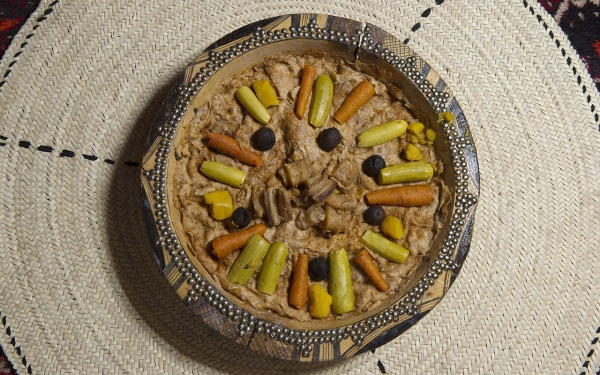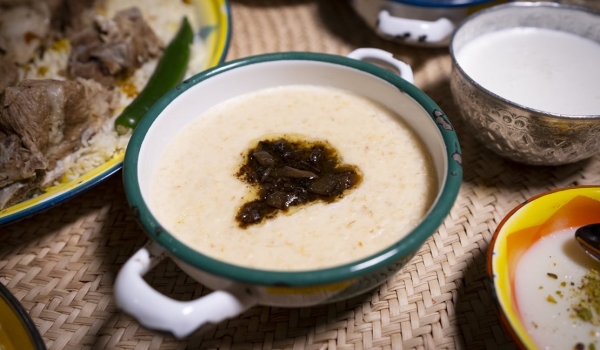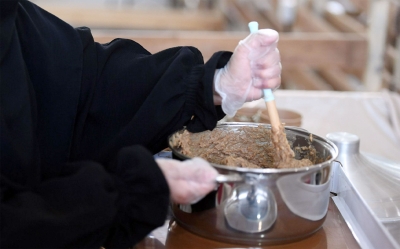


Traditional Food in Tabuk Province refers to dishes made by the inhabitants of Tabuk Province, located northwest of the Kingdom of Saudi Arabia. These dishes include seafood and traditional local dishes. They also vary according to the weather, as residents are keen to balance their love for seafood and meat-based dishes that supply warmth during winter. Moreover, some traditional dishes are served throughout the year.
Mafroukeh or Jamriyah
Due to the cold winter weather prevailing in Tabuk Province, dishes that enhance warmth, including Mafroukeh or Jamriyah, are prepared. These dishes consist of flour mixed with water to form a circular dough disk buried under coals for cooking. Dates, ghee, and honey are then added to the mixture. The mixture is rubbed manually, hence its Arabic name, Mafroukeh.
Fatteh
An old dish consisting of dough buried directly under coals after kneading. The dough turns into bread after cooking. It is then taken aside to remove impurities. The mixture is rubbed and poured with wild ghee and milk until it becomes ready for serving.
Jareesh
The dish consists of wheat grains crushed with a hand mill. The grains are cooked using heat, upon placing them in a pot with water or broth, and stirring the mixture with a wooden spoon known as al-miswat. The dish may be cooked with milk and some wild ghee poured thereon after the dough is cooked. Some others soak the dough in water and then cook it with meat and milk, while others like to cook it with tomatoes. Wild ghee or butter is usually added to the mixture. The dish is frequently prepared during the Holy Month of Ramadan.
Al-Mujallalah and al-Khumai'ah
The dish consists of dough cooked with heat rather than being buried under coals as the case is for the preparation of fattah. The dough is shaped into a disk, cooked, cut into small pieces poured into milk, and kneaded before adding ghee thereto. A distinction is drawn between both types of this dish: when ghee is added to the mixture, it is known as al-Mujallalah, while it is known as al-Khumai'ah once milk is added thereto.
Mansaf
This dish consists of meat, rice, and Shirak bread. However, the meat is cooked with Jameed, and then, the Shirak bread is dipped in the liquid resulting from melting Jameed, which is a type of hardened milk or other dairy. The Shirak bread is placed on top of a plate, covered with rice, and topped with meat and Jameed broth.
Marqooq
This dish consists of flour kneaded upon adding salt and water, ultimately forming a consistent and soft dough. It is left to rest for no less than twenty minutes. It is cooked with meat broth upon cooking the meat until half-cooked. Some add vegetables to the mixture. The dough is rolled until it becomes, placed in a pot along with meat, upon noting that the dough sheets should not be placed at once so they do not stick to one another nor form a large sheet. The mixture is then simmered on low heat until cooked.
Saleeg
The dish consists of white-soaked rice, boiled with chicken or meat, upon adding mastic and cardamom. The broth is then drained and rice is added to the residue. Once cooked, fluid milk is added to the mixture that should be constantly stirred. Chicken or meat are then cooked until they take a brown color. The dish is served with boiled rice.
Sayyadiyyah
It consists of fish cooked with rice. Preparation begins with cooking onion in a large quantity of oil until it turns into an almost burned brownish color, known as al-Kashnah. Then, fish pieces prepared in advance for the dish are added to al-kashnah. After the fish is removed, rice is cooked with the water in which the fish was cooked upon adding spices and pepper. Sometimes, ghee is added to the dish.
Seafood is a staple at Ramadan suhoor tables in the coastal cities of Tabuk Province. In fact, these dishes boast great nutritional value and benefits, provide the body with natural vitamins and minerals, and have low-fat content.
Related quizzes
Related articles

